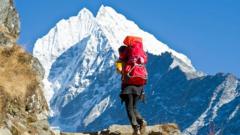Last year, climbing fees generated $5.9 million, with more than 75% of the revenue attributed to Everest climbs alone. The newly free peaks range in height from 5,970 meters to 7,132 meters and are expected to attract climbers looking for alternative mountainous adventures. Himal Gautam, director of Nepal's Tourism Department, emphasized the potential for job creation and local economic growth through increased tourism, as he acknowledged that access to these regions has historically been challenging.
However, concerns remain regarding the existing infrastructure and whether local communities can manage the potential surge of tourists. Over the past two years, only 68 climbers have attempted to conquer the 97 peaks, a stark contrast to the 421 permits issued for Everest in 2024 alone. This overwhelming interest in Everest has resulted in a slew of challenges, including overcrowding and environmental degradation, leading Nepal's Supreme Court to advocate for stricter permit regulations earlier this year.
As part of ongoing efforts to ensure safer climbing conditions, a new legislative proposal is under consideration, requiring climbers seeking to ascend Everest to have previously summited a mountain surpassing 7,000 meters in Nepal. This showcases the strategic importance of the peaks in Karnali and Sudurpaschim as suitable training grounds for more ambitious climbers.
Overall, the complimentary climbing initiative aims not just to revitalize tourism in neglected areas, but also to alleviate some of the pressure on Mount Everest while elevating Nepal's reputation as a destination for mountain enthusiasts.
However, concerns remain regarding the existing infrastructure and whether local communities can manage the potential surge of tourists. Over the past two years, only 68 climbers have attempted to conquer the 97 peaks, a stark contrast to the 421 permits issued for Everest in 2024 alone. This overwhelming interest in Everest has resulted in a slew of challenges, including overcrowding and environmental degradation, leading Nepal's Supreme Court to advocate for stricter permit regulations earlier this year.
As part of ongoing efforts to ensure safer climbing conditions, a new legislative proposal is under consideration, requiring climbers seeking to ascend Everest to have previously summited a mountain surpassing 7,000 meters in Nepal. This showcases the strategic importance of the peaks in Karnali and Sudurpaschim as suitable training grounds for more ambitious climbers.
Overall, the complimentary climbing initiative aims not just to revitalize tourism in neglected areas, but also to alleviate some of the pressure on Mount Everest while elevating Nepal's reputation as a destination for mountain enthusiasts.





















